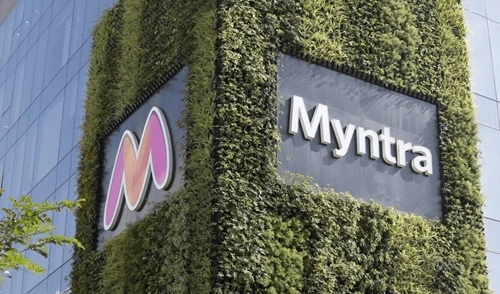Myntra, India’s premier fashion e‑commerce destination under Flipkart, achieved a significant turnaround in FY 2024. Its revenue from operations jumped 14.7% to ₹5,121.8 crore, driven by growth in logistics (₹2,439 crore), marketplace (₹1,774.6 crore), and advertising (₹712.3 crore) income. More notably, Myntra swung from a FY 2023 loss of ₹782 crore to a net profit of ₹31 crore in FY 2024, supported by disciplined cost management—material costs fell 7.8%, and ad spend dropped 4.6%. Under CEO Nandita Sinha, the platform also became EBITDA‑positive in late 2023. In an industry where India’s fashion e‑commerce market is projected to grow from $24.9 billion in 2025 at a CAGR of ~25%, Myntra’s blend of profitability and scale is especially notable. Against this backdrop, here’s a detailed SWOT analysis.

Strengths
1. Profitability turnaround & revenue momentum: Achieving a ₹31 crore profit turned the tide for Myntra. FY 2024 revenue of ₹5,122 crore marked ~15% YoY growth, while EBITDA profit came in during two consecutive quarters—signaling a viable path to sustainable business.
2. Diverse revenue streams: Nearly half of operating income came from logistics, supplemented by stable marketplace margins and 33% growth in advertising revenue . This diversified structure reduces reliance on direct sales.
3. Technology leadership & personalization: Myntra leverages AI-powered features like MyFashionGPT, stylist assistants, virtual try-ons, and UGC tools (“Myntra Minis”), boosting engagement among ~75 million users.
4. Premium positioning & brand partnerships: With a strong focus on premium and international brands—alongside beauty and ethnic wear—Myntra stands out among competitors.
5. Omnichannel & express delivery: Innovations such as 24–48 hour Express deliveries (M‑Express), quick-commerce pilot, and Myntra Fashion Superstar keep the platform consumer‑centric and timely.
Weaknesses
1. Thin margins and low profit levels: While profitable, margins remain slim—a ₹31 crore profit on ₹5,122 crore means tight earnings power, leaving little buffer for expenditure missteps.
2. High marketing and retention costs: Aggressive promotional campaigns and a need to reduce ~30–40% return rates continue to pressure the cost base.
3. Dependence on urban, young demographics: Core business is concentrated in Tier-1/2 cities with millennials; further reaching Tier-3/4 consumers may require differentiated strategies.
4. Competitive overlap within Flipkart ecosystem: Marketing overlap with Flipkart Fashion may dilute Myntra’s unique brand identity and strategic clarity.
Opportunities
1. Quick commerce expansion: With express delivery and quick-commerce pilots gathering pace, logistics revenue could grow 20–25% YoY if successful.
2. Fashion-driven social commerce: Features like Myntra Minis and Myntra Fashion Superstar enable deeper social engagement and trend-led discovery.
3. Penetrating new city tiers: As internet penetration increases, fashion e‑commerce in smaller cities offers substantial growth potential.
4. Growing beauty and ethnic wear segments: Expanding beauty offerings and ethnic wear during festivals can cross-sell to existing users and increase basket value.
5. AI-powered hyper-personalization: Advanced recommendation engines, dynamic ad creatives, and personalization can improve conversion and reduce returns .
Threats
1. Fierce competition & price wars: Rivals like Ajio, Amazon, Flipkart, and homegrown D2C brands increasingly undercut Myntra on price and promotions.
2. Rising costs from returns and logistics: Fashion’s return rates remain high (~30–40%), and addressing this—e.g., via discounts—can erode margins.
3. Economic slowdown risk: Sluggish consumer sentiment or inflation could hurt discretionary purchases like fashion and beauty.
4. Brand dilution risk: Expanding into sub‑brands or JVs may dilute Myntra’s premium market proposition.
5. Data/security vulnerabilities: As a platform heavy on AI and personalization, any data breach or algorithmic bias can harm customer trust.
Future Outlook
Entering FY 2025 and beyond, Myntra is at a strategic inflection point. With analysts predicting ₹5,800–5,900 crore) and further profitability gains in FY 2025, the company aims to build on its momentum. The Indian fashion e‑commerce market, expected to exceed $24.9 billion in 2025 with ~25% CAGR, offers a fertile landscape.
Key strategic imperatives:
Scale quick-commerce/logistics to capitalize on faster delivery as a loyalty lever and high-margin revenue stream.
Invest in AI-personalization, reducing returns and enhancing user experience through features like virtual styling.
Grow beyond core urban markets, tailoring assortments and price points for Tier‑3/4 consumers.
Deepen beauty and ethnic offerings, aligning with consumer trends and expanding basket value.
Maintain margin discipline, even as marketing, logistics, and tech investments ramp up.
If Myntra can sustain its cost efficiency, extend its reach through express delivery, and deepen engagement via tech and personalization—all without compromising brand identity—it is well‑positioned to lead India’s fast‑evolving fashion e‑commerce landscape well into the next decade.